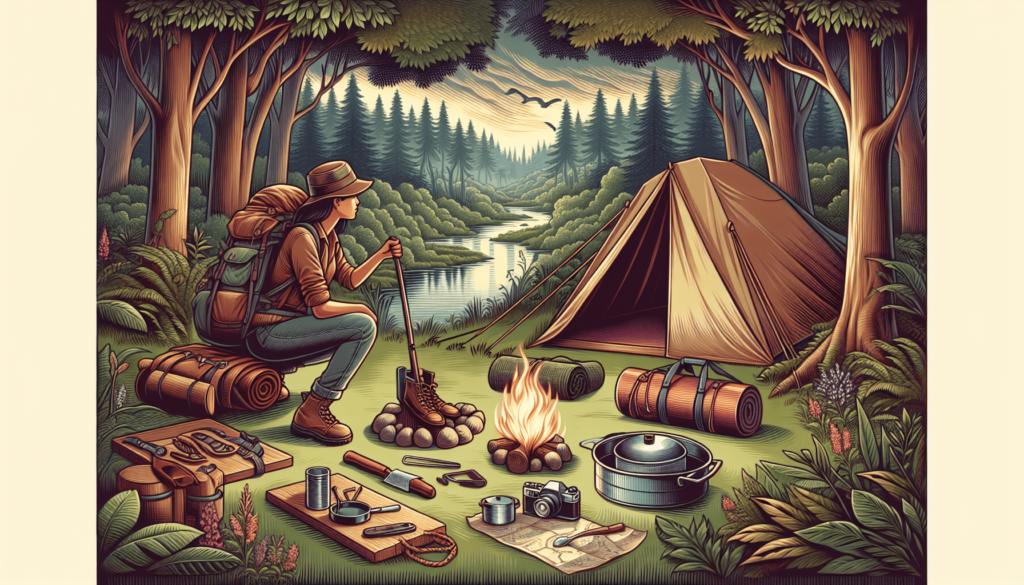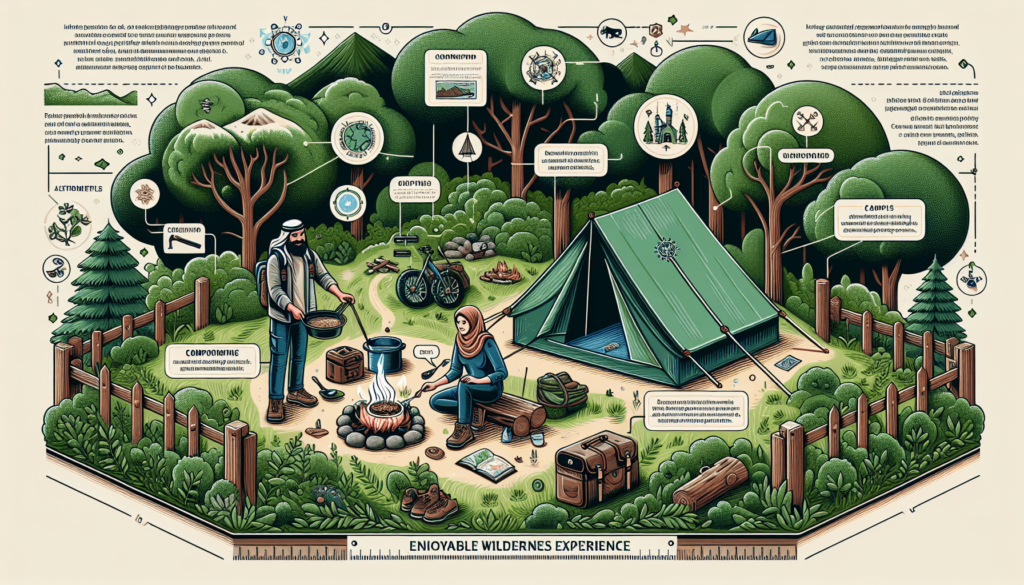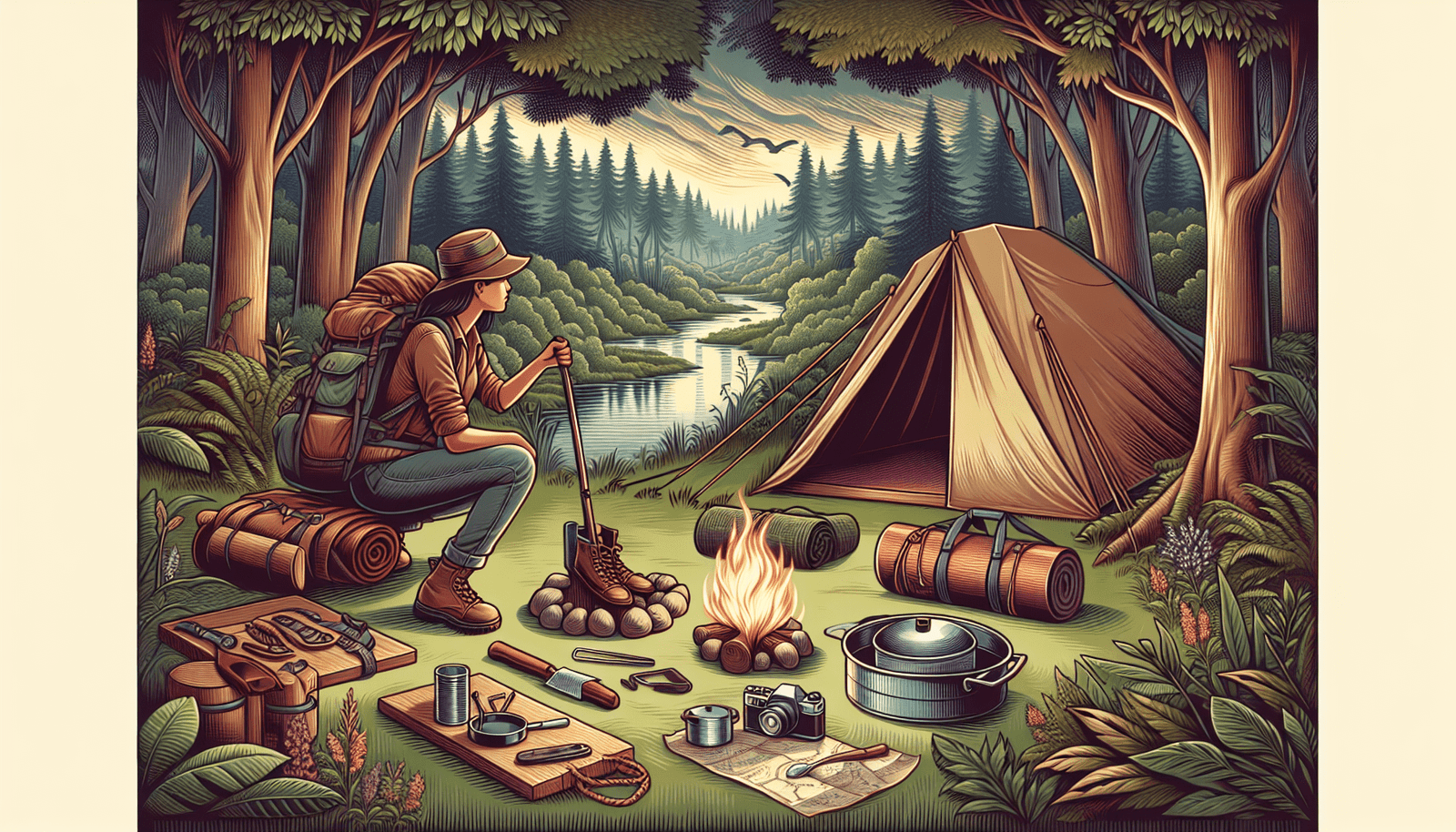Are you ready to take your wilderness survival skills to the next level? In my blog, “The Survivalist Handbook,” I am here to guide you beyond the basics and help you achieve wilderness comfort. Whether you’re an adventure enthusiast or simply interested in being prepared, these skills are crucial for anyone venturing into the great outdoors. From building a cozy shelter to foraging for edible plants, my comprehensive collection of articles in the “Wilderness Survival” category will equip you with the knowledge and techniques needed to thrive in any wilderness environment. Get ready to embrace the wild with confidence as you learn to survive and thrive!
Shelter and Sleeping
When it comes to venturing out into the wilderness, having proper shelter and a comfortable sleeping arrangement is crucial for your overall well-being. Let’s explore some options to ensure you have a cozy and safe place to rest during your outdoor adventures.
Tent or Tarp
Having a reliable shelter is of utmost importance when spending time in the wilderness. A good tent or tarp can provide protection from rain, wind, and other elements, ensuring you stay dry and comfortable during your nights outdoors. Look for a tent that is durable, easy to set up, and suits the number of people you’ll be camping with. If you prefer a more minimalist approach, a tarp can also be a lightweight and versatile option for creating a shelter.
Sleeping Bag or Hammock
Getting a good night’s sleep is essential, and having the right sleeping gear can make all the difference. A high-quality sleeping bag will keep you warm and cozy even in chilly temperatures. Look for one that is suitable for the climate you’ll be camping in and consider factors such as insulation, weight, and packability. Alternatively, if you prefer a more unique sleeping experience, a hammock can be a comfortable and portable option, allowing you to easily set up in various locations.
Sleeping Pad or Mat
To add an extra layer of comfort and insulation between you and the ground, consider investing in a sleeping pad or mat. These lightweight and compact accessories can provide cushioning and insulation to help you sleep better, especially on uneven or rough surfaces. Look for options that are durable, easy to inflate and deflate, and provide sufficient insulation for the temperatures you’ll be camping in.
Cooking and Food
Nothing beats a warm and hearty meal when you’re out in the wild. Having the right cooking equipment and knowing how to store and preserve food are essential for a satisfying culinary experience. Let’s dive into some key considerations for cooking and food in the wilderness.
Portable Stove or Grill
A portable stove or grill can make cooking a breeze while camping. These compact and lightweight devices allow you to cook meals efficiently and safely. Look for options that are fuel-efficient, easy to use, and suitable for your cooking needs. Some stoves even come with built-in igniters, making fire-starting hassle-free. If you prefer a more rustic approach, a portable grill can be a great option for cooking food over an open fire.
Cookware and Utensils
Investing in high-quality cookware and utensils can elevate your camping meals. Look for lightweight and durable options that are easy to pack and clean. Consider items such as pots, pans, utensils, plates, and cups that suit your cooking style and needs. You may also want to bring a multi-tool or pocket knife for various tasks, such as cutting ingredients or opening cans.
Food Storage and Preservation
Properly storing and preserving your food is crucial to prevent spoilage and ensure your meals stay fresh while camping. Invest in airtight containers or resealable bags to keep your food safe from moisture and pests. It’s also important to store perishable items in a cooler with ice or ice packs to maintain their freshness. Additionally, consider bringing non-perishable food items, such as dried fruits, nuts, or protein bars, as emergency backup options.

Water and Hydration
Staying hydrated is essential for your health and well-being, especially when engaging in outdoor activities. Finding and purifying water sources in the wilderness is vital to ensure you have a safe and abundant supply. Let’s explore some key considerations for water and hydration during your outdoor ventures.
Water Filter or Purifier
When camping in the wild, it’s crucial to have a reliable method of purifying water to make it safe for consumption. A water filter or purifier can remove harmful bacteria, parasites, and other contaminants from natural water sources. Look for options that are lightweight, easy to use, and capable of filtering a sufficient amount of water for your needs. Consider factors such as filter lifespan and the type of water sources you’ll encounter.
Water Bottles or Reservoirs
Having a sturdy and portable water container is essential for carrying and accessing water during your outdoor adventures. Look for water bottles or reservoirs that are durable, leak-proof, and easy to clean. Insulated options can also help keep your water cool in hot temperatures. Consider the capacity that suits your hydration needs and the availability of water sources in the areas you’ll be exploring.
Hydration Bladder or Pack
If you prefer a hands-free hydration option, a hydration bladder or pack can be a convenient choice. These systems typically consist of a bladder with a drinking tube that can be attached to a backpack. Look for options that are leak-proof, easy to clean, and provide sufficient storage for other essentials. Make sure to regularly check and clean your hydration system to prevent bacteria growth and ensure the water remains fresh.
Clothing and Gear
Proper clothing and gear can make a significant difference in your comfort and safety during outdoor activities. Dressing appropriately for the weather conditions and ensuring you have the right footwear are crucial considerations. Let’s explore some key aspects of clothing and gear for survival in the wilderness.
Layering System
When it comes to clothing, layering is the key to adaptability in changing weather conditions. Consider a three-layer system consisting of a base layer, insulation layer, and outer shell. A moisture-wicking base layer will keep you dry by pulling sweat away from your skin. An insulation layer, such as a fleece or down jacket, will provide warmth. Finally, an outer shell, like a waterproof and windproof jacket, will protect you from rain, snow, and wind.
Waterproof and Windproof
Having waterproof and windproof gear is essential for staying dry and comfortable during unpredictable weather situations. Look for jackets, pants, and footwear that offer reliable protection from rain, snow, and wind. Pay attention to features such as sealed seams, waterproof zippers, and adjustable cuffs for a secure fit. Additionally, consider investing in gaiters to keep your lower legs and feet dry in wet and muddy conditions.
Proper Footwear
Investing in high-quality and appropriate footwear is crucial for your comfort and safety in the wilderness. Look for hiking boots or shoes that offer good traction, ankle support, and durability. Consider the terrain you’ll be traversing and the weather conditions you’re likely to encounter. It’s also important to wear moisture-wicking socks that provide cushioning and prevent blisters. Don’t forget to break in your footwear before embarking on a long hiking trip to avoid discomfort and blisters.

Navigation and Communication
When exploring the wilderness, it’s essential to have the means to navigate your surroundings and communicate effectively in case of emergencies. Let’s discuss some key considerations for navigation and communication during your outdoor adventures.
GPS Device or Compass
Having a reliable navigation tool is crucial for orientation in the wilderness. A GPS device can provide accurate positioning and help you track your routes. Look for options that have a long battery life and preloaded topo maps. Additionally, consider bringing a compass as a backup in case your GPS device malfunctions or runs out of battery. Familiarize yourself with how to use a compass properly to navigate effectively.
Map and Navigation Tools
Carrying a detailed map of the area you’ll be exploring is essential for understanding the geography and planning your routes. Look for topographic maps that provide information about elevation, terrain, and landmarks. Familiarize yourself with map reading and basic navigation skills to effectively navigate using compass bearings and landmarks. It can also be beneficial to bring a guidebook or a trail map for reference and additional information about the area.
Signal Device or Whistle
In emergency situations, being able to signal for help is crucial. Carrying a signal device, such as a whistle or a signaling mirror, can attract attention and alert rescuers to your location. Make sure to keep the signal device easily accessible, preferably attached to your gear or clothing. Learn and practice different signaling methods using international distress signals, sound patterns, or visual cues to increase your chances of being noticed and rescued.
First Aid and Emergency Preparedness
Being prepared for emergencies and having the necessary first aid supplies can be a lifesaver in the wilderness. Let’s explore some key considerations for first aid and emergency preparedness during your outdoor adventures.
First Aid Kit
Having a well-stocked first aid kit is essential for treating minor injuries and managing medical emergencies. Look for a comprehensive kit that includes items such as bandages, adhesive tape, antiseptic wipes, tweezers, and medications for pain relief and allergies. Additionally, consider including items specific to your needs, such as prescription medications, blister treatments, and items for managing potential outdoor hazards, like snake bites or ticks.
Emergency Shelter or Blanket
In case of unexpected circumstances, having an emergency shelter or blanket can provide protection and warmth. Look for lightweight and compact options, such as emergency bivvies or thermal blankets, that can be easily stowed in your backpack. These items can help retain body heat and offer temporary shelter in case you become stranded or need to wait for help.
Fire Starter and Signaling
Fire is a valuable survival tool that provides warmth, heat for cooking, and signaling capabilities. Carrying a reliable fire starter, such as waterproof matches, a lighter, or a fire starter rod, is crucial. Familiarize yourself with fire-building techniques and gather appropriate tinder, kindling, and fuel sources before your trip. Additionally, consider bringing brightly colored or reflective materials that can be used for signaling in case of emergencies.
Personal Care and Hygiene
Taking care of personal hygiene and staying clean while camping can greatly contribute to your overall comfort and well-being. Let’s explore some essential considerations for personal care and hygiene during your wilderness adventures.
Toiletries and Personal Items
Bringing basic toiletries and personal items can help you maintain hygiene standards and feel fresh during your outdoor escapades. Pack items such as toothbrush, toothpaste, biodegradable soap, hand sanitizer, and toilet paper. Consider using compact and travel-sized options to save space in your backpack. Additionally, don’t forget to bring any necessary medications or personal items specific to your needs.
Portable Shower or Wipes
Maintaining cleanliness in the wilderness can be challenging, but portable shower systems or wipe products can help you freshen up. Portable showers are available in various designs, including solar-powered options that can heat water using the sun’s energy. Alternatively, biodegradable wipes can be a convenient option for quick clean-ups when water is scarce. Remember to follow Leave No Trace principles by properly disposing of any waste.
Hand Sanitizer and Sunscreen
Keeping your hands clean is crucial for preventing the spread of germs, especially in outdoor environments where access to running water may be limited. Carry hand sanitizer that contains at least 60% alcohol and use it before eating or after using the restroom. Additionally, protect your skin from the sun’s harmful rays by applying sunscreen regularly. Look for broad-spectrum options with a high SPF rating and consider bringing lip balm with SPF as well.
Entertainment and Comfort
While the wilderness offers its own natural beauty and serenity, adding some entertainment and comfort items can enhance your overall camping experience. Let’s explore some key considerations for entertainment and comfort during your outdoor adventures.
Books and Games
Bringing along books, magazines, or portable games can provide entertainment during downtime or when weather conditions prevent outdoor activities. Choose lightweight options that suit your interests and preferences. Consider games that can be easily played in a small group, such as card games or travel-sized board games. If reading is your preferred form of relaxation, opt for e-books or compact paperbacks to save on space.
Portable Chair or Hammock
Creating a comfortable seating or lounging area can greatly enhance your camping experience. Consider bringing a portable chair or a hammock that is lightweight, compact, and easy to set up. Portable chairs can provide back support and comfort around the campfire, while hammocks offer a relaxing spot to unwind and enjoy nature. Look for options that are sturdy, breathable, and designed for outdoor use.
Portable Solar Charger
With technology becoming an integral part of our lives, staying connected and powered up in the wilderness is essential for some outdoor enthusiasts. A portable solar charger can harness the sun’s energy to charge your electronic devices, such as smartphones or GPS devices. Look for options that are lightweight, durable, and compatible with the devices you’ll be bringing. Having a charged device can be useful for emergency communication or capturing memorable moments through photography.
Wildlife Safety and Protection
When venturing into the wilderness, it’s important to respect and coexist with the wildlife that call these areas home. However, taking precautions to ensure your safety and protect both yourself and the wildlife is essential. Let’s explore some key considerations for wildlife safety and protection during your outdoor adventures.
Bear Spray or Pepper Spray
In areas known for bear or wildlife encounters, carrying bear spray or pepper spray can be an effective deterrent. These sprays emit a strong odor that can deter wildlife from approaching too closely. Familiarize yourself with how to properly use these sprays, including the range and technique for optimal effectiveness. It’s important to follow local regulations and guidelines regarding wildlife encounters and the use of bear or pepper spray.
Insect Repellent or Netting
Protecting yourself from insects, such as mosquitoes and ticks, is crucial for your comfort and health in the wilderness. Applying insect repellent to exposed skin can help keep bugs at bay. Look for options that contain ingredients like DEET or picaridin and follow the instructions for application. Additionally, consider bringing mosquito netting or wearing lightweight, long-sleeved clothing and pants to further protect yourself from bites.
Animal-resistant Food Storage
Preventing wildlife from accessing your food is not only important for your safety but also for the well-being of the animals. Ensure you have proper food storage containers that are animal-resistant, such as bear canisters or hanging systems, depending on the recommendations for the specific area you’ll be camping in. Practice proper food storage techniques to minimize interactions between humans and wildlife and maintain a healthy ecosystem.
Mental and Emotional Well-being
While physical preparedness is vital in the wilderness, it’s equally important to prioritize your mental and emotional well-being. Let’s explore some key considerations for maintaining mental and emotional wellness during your outdoor adventures.
Mindfulness and Meditation
Practicing mindfulness and meditation can help you connect with nature, reduce stress, and enhance your overall well-being in the wilderness. Set aside some time each day to engage in meditation or mindfulness exercises, such as focusing on your breath or taking in the sounds and sensations of nature. Use these moments to cultivate gratitude and be present in the beauty of the natural world around you.
Journaling or Reflective Practices
Keeping a journal or engaging in reflective practices can be a fulfilling way to process your experiences and emotions while spending time in the wilderness. Take the time to write down your thoughts, observations, and reflections on your outdoor adventures. This practice can help you gain perspective, preserve memories, and deepen your connection with nature.
Positive Affirmations and Self-Care
Engaging in positive affirmations and self-care practices can foster a positive mindset and boost your overall well-being. Repeat positive affirmations that resonate with you and help cultivate a sense of confidence and inner strength. Additionally, prioritize self-care activities that bring you joy and relaxation, such as reading, taking a nature walk, or practicing yoga. Remember to be kind and patient with yourself during your outdoor adventures.
In conclusion, venturing into the wilderness can be an incredibly rewarding experience when you are well-prepared and equipped. By ensuring you have suitable shelter, comfort, and safety provisions, you can truly thrive in any outdoor environment. Remember to prioritize your physical and mental well-being, embrace the beauty of nature, and always practice responsible wilderness ethics. With the tips and considerations provided in this article, you’ll be well on your way to surviving and thriving in the great outdoors. Happy exploring!

